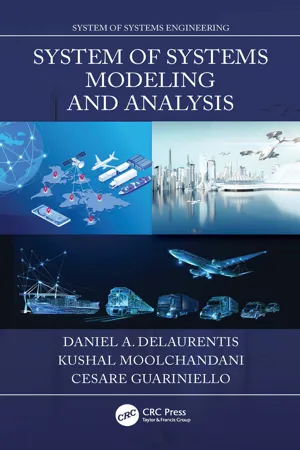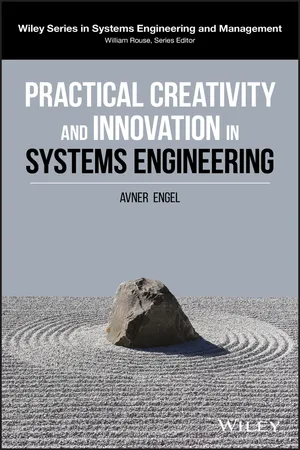Technology & Engineering
Systems Engineering
Systems Engineering is an interdisciplinary approach to designing, analyzing, and managing complex systems over their life cycles. It integrates various engineering disciplines and focuses on the interactions between different components to ensure the overall system functions effectively. This approach emphasizes the importance of considering the system as a whole, rather than just its individual parts.
Written by Perlego with AI-assistance
Related key terms
12 Key excerpts on "Systems Engineering"
- eBook - ePub
- Benjamin S. Blanchard, John E. Blyler(Authors)
- 2016(Publication Date)
- Wiley(Publisher)
Systems Engineering is an interdisciplinary approach and means to enable the realization of successful systems. It focuses on defining customer needs and required functionality early in the development cycle, documenting requirements, and then proceeding with design synthesis and system validation while considering the complete problem. Systems Engineering considers both the business and technical needs of all customers with the goal of providing a quality product that meets the user needs.The Department of Defense (DOD) defines system engineering as follows:An approach to translate approved operational needs and requirements into operationally suitable blocks of systems. The approach shall consist of a top-down, iterative process of requirements analysis, functional analysis and allocation, design synthesis and verification, and system analysis and control. Systems Engineering shall permeate design, manufacturing, test and evaluation, and support of the product. Systems Engineering principles shall influence the balance between performance, risk, cost, and schedule.Wikipedia defines Systems Engineering as:13More specifically:An interdisciplinary field of engineering that focuses on how to design and manage complex systems over their life cycles.—Systems Engineering ensures that all likely aspects of a project or system are considered, and integrated into a whole.The Systems Engineering process shall:14- Transform approved operational needs and requirements into an integrated system design solution through concurrent consideration of all life-cycle needs (i.e., development, manufacturing, test and evaluation, deployment, operations, support, training, and disposal), and
- Ensure the interoperability and integration of all operational, functional, and physical interfaces. Ensure that system definition and design reflect the requirements for all system elements to include hardware, software, facilities, people, and data, and
- eBook - ePub
- Howard Eisner(Author)
- 2012(Publication Date)
- Mercury Learning and Information(Publisher)
Systems Engineering is a discipline that concentrates on the design and application of the whole (system) as distinct from the parts. It involves looking at a problem in its entirety, taking into account all the facets and all the variables and relating the social to the technical aspect.INCOSE goes on to present this author’s definition [INCOSE11, Eisner08], namely:Systems Engineering is an iterative process of top-down synthesis, development, and operation of a real-world system that satisfies, in a near optimal manner, the full range of requirements for the system.NASA
The National Aeronautics and Space Administration (NASA) has been a very positive force in the building of large, complex systems. Its definition takes the following forms [NASA07]:Systems Engineering is a methodical, disciplined approach for the design, realization, technical management, operations, and retirement of a system.Systems Engineering is the art and science of developing an operable system capable of meeting requirements within often opposed constraints. Systems Engineering is a holistic, integrated discipline, wherein the contributions of [various kinds of engineers] are evaluated and balanced, one against another, to produce a coherent whole that is not dominated by the perspective of a single discipline.DoD
A U.S. Department of Defense (DoD) definition [Eisner08, DoD12] that is appropriate for our purposes here is that Systems Engineering:Involves design and management of a total system which includes hardware and software, as well as other system life-cycle elements. The Systems Engineering process is a structured, disciplined, and documented technical effort through which systems products and processes are simultaneously denned, developed, and integrated. Systems Engineering is most effectively implemented as part of an overall integrated product and process development effort using multidisciplinary teamwork. - eBook - ePub
Engineering Information Security
The Application of Systems Engineering Concepts to Achieve Information Assurance
- Stuart Jacobs(Author)
- 2015(Publication Date)
- Wiley-IEEE Press(Publisher)
2 Systems Engineering2.1 So What is Systems Engineering?
Systems Engineering is a methodical approach to the specification, design, creation, and operation of a function. In simple terms, Systems Engineering consists of:- identification and quantification of system goals and objectives;
- development of functional and performance requirement statements that capture those capabilities necessary to fulfill the identified goals and objectives;
- creation of alternative system design concepts that comply with the functional and performance requirements;
- performance, cost–benefit, and trade-off analyses for each alternative design;
- selection, implementation, and deployment of the chosen design;
- verification that the design is properly built, integrated, deployed, operated/managed; and
- post-deployment assessment of how well the system meets (or met) the goals.
andThe concept from the engineering standpoint is the evolution of the engineering scientist, i.e., the scientific generalist who maintains a broad outlook. The method is that of the team approach. On large-scale system problems, teams of scientists and engineers, generalists as well as specialists, exert their joint efforts to find a solution and physically realize it…. The technique has been variously called the systems approach or the team development method.1The Systems Engineering method recognizes each system as an integrated whole even though composed of diverse, specialized structures and sub-functions. It further recognizes that any system has a number of objectives and that the balance between to optimize the overall system functions according to the weighted objectives and to achieve maximum compatibility of its parts.2Systems Engineering focuses on defining customer needs and required functionality early in the development cycle and then refining and documenting requirements that represent those needs. This approach continues into design synthesis, development, system validation, deployment, operation, and retirement while considering the complete problem (system life cycle). - eBook - ePub
- Daniel A. DeLaurentis, Kushal Moolchandani, Cesare Guariniello(Authors)
- 2022(Publication Date)
- CRC Press(Publisher)
2 What Is System of Systems Engineering?2.1 OVERVIEW OF Systems Engineering
We defined a system as a collection of elements which provides capabilities that no single element can provide alone. The additional capabilities, beyond that of individual elements, are the result of interactions among those elements. We intentionally exploit this quality of systems, that of providing greater capabilities than those that their elements provide in isolation, by bringing together a set of elements and designing their interactions to achieve desired capabilities. However, as systems increase in complexity, we need to assemble larger numbers of elements, account for more complex and interaction patterns and policies, and try to drive the system towards behaviors which are generally non-linear and become increasingly more difficult to predict. The increase in system complexity, therefore, also increases the value of using principles and patterns of systems thinking for design and engineering of systems. Application of systems thinking provides us with a structured approach for designing and building better systems to fulfill our needs; this is referred to as Systems Engineering (SE):- “[Systems Engineering is] an interdisciplinary approach and means to enable the realization of successful systems.” [167 ]
- “Systems Engineering is a process employed in the evolution of systems from the point of when a need is identified through production and/or construction and ultimate deployment of that system for consumer use.”[22 ]
- “Systems Engineering is a robust approach to the design, creation, and operation of systems.” [97 ]
An SE approach helps satisfy the needs of not just the end users, but those of all stakeholders including the organization building those systems, the operators, and even the regulators. Frequently, different stakeholders have differing expectations of the system. For example, from the customer's viewpoint, the purpose of SE is to find the best solution to their problem, while from the organization's viewpoint the purpose is to manage the risk involved during the process of building systems [33 ]. Meeting different stakeholders’ needs involves ensuring that the organizational, cost, and technical aspects are balanced against each other, even when such needs are conflicting with one another [97 - eBook - ePub
- Robert S. Alford(Author)
- 2018(Publication Date)
- CRC Press(Publisher)
4Systems Engineering 4.1 The Systems Engineer 4.2 Product Planning 4.3 Developing the System Architecture 4.4 Project Management 4.5 Build vs. Buy Decisions 4.6 Major Component Selection 4.7 Prototype Systems 4.8 System Integration and Test 4.9 Summary Further ReadingSystems Engineering is the process of selecting and synthesizing the application of the appropriate scientific and technological knowledge in order to translate system requirements. Wilton P. ChaseManagement of System EngineeringDuring the early days of computer systems it was very common for an engineering organization to be built strictly around hardware/software lines. Typically there would be a software organization that was responsible for developing the code, and a hardware organization that was responsible for everything else. To this day, some organizations continue to be structured around software/hardware lines. For engineering organizations responsible for systems development, where the system contains both hardware and software, this simple division of disciplines has proven to be inadequate. The difficulty is that the hardware people look after the hardware, and the software people look after the software, but the product is a system, and what is needed is someone to look after the system as a whole.Systems engineers have been around for many years in other areas of technology, but the use of systems engineers and the discipline of system engineering in computer system development is fairly recent. In this chapter we will examine the role of Systems Engineering in such an environment. This will be defined in fairly broad terms.It has been my experience that good systems engineers can, and should play a very broad role in computer systems development. It has also been my experience that good - eBook - ePub
Systems Engineering for Projects
Achieving Positive Outcomes in a Complex World
- Lory Mitchell Wingate(Author)
- 2018(Publication Date)
- Auerbach Publications(Publisher)
This separation was driven by the move to digital technology from mechanical and analog electronics. With smaller, more cost-effective components, products could be designed, produced, and made available to a wide population at reasonable costs. This shift in focus brought about the processes that would make up the discipline of Systems Engineering. In fact, the words “Systems Engineering” were first used in the 1940s by Bell Telephone Laboratories, where primary activities of systems engineers—optimization modeling, queuing theory, and probability theory—were being used to solve problems associated with broad military systems during World War II. 1 The RAND Corporation had also been developing analogous processes associated with systems analysis that would also tie directly into the Systems Engineering discipline. 2 As the digital revolution drove incredible growth in industry, complicated and complex systems were developed, produced, and brought to market. Methods were created to carefully capture the stakeholders’ requirements and to ensure that the incorporation of all disciplines (including software development) were put into place and incorporated into the processes, so that the final product or service had the highest probability of meeting the stakeholders’ expectations. The United States Department of Defense and the National Aeronautics and Space Administration were both early adopters of this systematic, integrated approach to the product life cycle. The complexity of the systems that they were developing for both war fighting and space exploration required a methodical approach that would provide the rigor needed throughout the design, development, production, and operations of these highly integrated systems so that they could be operated safely, securely, and with the intended results. By the later part of the century, the need for an integrated systems approach was clear. Systems built on heavy software–hardware interactions and interfaces had emerged - eBook - ePub
Systems Engineering
Holistic Life Cycle Architecture Modeling and Design with Real-World Applications
- Sandra Furterer(Author)
- 2021(Publication Date)
- CRC Press(Publisher)
When we first start the semester in the Management of Engineering Systems course, my students, who come from a variety of engineering disciplines, including civil and environmental engineering, industrial engineering, chemical and materials engineering, mechanical engineering, and electrical and computer engineering, expect that they will be “designing” a system. As we delve further into the definition of Systems Engineering, and even into the application of the Systems Engineering tools, they begin to understand that the systems engineer and the Systems Engineering functions encompass the connective tissue across the Systems Engineering life cycle. Systems engineers don’t design the system, per se, but they help to define the systems concepts, they facilitate the collection of the customers’ and systems’ requirements, and they model the system architecture. All of those activities enable the specialty engineers to design the product and mechanical systems, the electrical systems, and the software and hardware systems. The systems engineer aids in ensuring the integration of the systems elements and the verification and validation of the systems. They identify and mitigate risk. They are involved in the Systems Engineering planning functions. Depending upon the specific organization, some of these activities and functions may vary, as to who performs them.1.4 Why Is Systems Engineering Necessary
Systems thinking, the systems approach, and Systems Engineering have become more important in the world today. Complexity of our systems increases due to the speed of technology change and shorter life cycles. As more software applications guide our evolving systems, to achieve more autonomy and intelligence, the need to understand and test the interconnectivity between the hardware, the software, and the customers’ requirements becomes more important. Our world is increasingly becoming more connected and reliant on each other through global supply chains. Enhanced competition in the marketplace contributes to pressures to design, develop, test, and deploy systems more quickly. Many organizations still lack basic infrastructure related to the maturity of design and operational processes, making Systems Engineering processes precarious and risky, but ever more important (Blanchard and Blyler, 2016 - Francis Hegarty, John Amoore, Paul Blackett, Justin McCarthy, Richard Scott(Authors)
- 2017(Publication Date)
- CRC Press(Publisher)
This implies that, as noted earlier, we include metrics and measurements in our systems approach. Chapter 1 has described the Value measure, the benefit delivered relative to the cost of achieving it. Introductory thoughts on measurements will be provided in this chapter, whilst Chapters 5 and 6 will expand on healthcare technology management (HTM) performance measures. • Third, the clinical engineer, with their methodical working, instinctive tendency to measure and focus on objectives can apply this structured approach beyond the confines of HTM to the wider healthcare system. 2.2 INTRODUCTION TO Systems Engineering Let’s start by restating the INCOSE definition of Systems Engineering as ‘an engineering discipline whose responsibility is creating and executing an interdisciplinary process to ensure that the customer and stakeholder’s needs are satisfied in a high quality, trustworthy, cost efficient and schedule compliant manner throughout a system’s entire life cycle’ (INCOSE 2016). Viewing objects, organizations and operating processes from a Systems Engineering approach has many advantages. It offers a structured method of analyzing each in detail, of examining the interactions between their constituent elements, whilst maintaining focused on the system’s overall aim, its purpose. The approach helps to ensure full understanding of each element’s characteristics, strengths and weaknesses, and how the elements interact. It recognizes that, important as each element is, it is the working together of the elements, their collective interactions, that achieves the system’s objective. The Systems Engineering approach, when applied to some systems, may reveal that optimizing each and every element that makes up the system may not improve the system as a whole- eBook - ePub
- Soobhiraj Bungsraz(Author)
- 2020(Publication Date)
- Palgrave Macmillan(Publisher)
1998 ). The SE design process develops this orderliness through a system’s specification. Specification aims to deliver at the system level a function that is self-sufficient so that it meets an identified need for the life of the system. Though SE finds extensive use in Defence, it is as a means to develop solutions to complex problems; for example, Configuration Management technique discussed below is used by non-military to manage costs and obsolescence for projects during their life cycle. The System of System (SoS) construct from SE allows the development of capabilities created by integrating autonomous systems to meet the need for managing emergencies, natural disasters and large bush fires as mentioned below.2 Emergence of Systems Engineering
System engineering (SE) has its root in systemology and was developed during the 1940s to respond to military need for a means to understand a system in operation (Blanchard and Fabrycky 1998 : 10). The need in the military was to develop large and complex systems. Systems deliver specific functions, roles or missions for the military, developing these systems and operating them required interdisciplinary expertise and knowledge. This military interdisciplinary need to solve cross-disciplinary problems gave rise to an initial form of interdisciplinary fields’ cooperation to develop systemic solutions, which was termed as systemology. Derived from general system theory, systemology was applied by US Department of Defense from its need to understand a host of common processes in military operation across its systems, and it developed, for example, operations research.This initial research to find what was common in military processes with systemology led to the creation of a body of knowledge that allowed other disciplines to emerge like SE (Blanchard and Fabrycky 1998 ). SE has an emphasis on technical integration for solving a need using inter-disciplinary teams. Integration of many disciplines, engineering and non-engineering allowed SE to build large systems from component level to create complex functions at the supra-system level. The military required complex functions which could not have been built without the interdisciplinary know-how, like building an aircraft from engineering and pilot’s ideas (conceptual) to its retirement (post operational life). Such a complex engineering enterprise requires various specialist and generalist fields to work together. SE as a methodology was developed to facilitate design of large and complex technical systems for the military weapon systems (USAF 2010 - eBook - ePub
- Joseph E. Kasser(Author)
- 2020(Publication Date)
- CRC Press(Publisher)
Section 2.5 ) to problem-solving. Moreover, it can be, and is, used in all disciplines for tackling certain types of complex and non-complex problems; see ‘[Systems Engineering] is a philosophy and a way of life’ (Hitchins 1998).* For example, my first job as a systems engineer was as an Apollo Lunar Surface Experiment Package (ALSEP) Control System systems engineer. Each experiment in the ASLEP had its own systems engineer, and there was a systems engineer for the ALSEP itself.6.5.6 The Five Layers of Systems Engineering
There are differences between Systems Engineering as performed on products, systems and large-scale systems. Hitchins proposed a five-layer model for Systems Engineering (Hitchins 2000) (Section 1.2 ) which can be extended downwards to add a sixth layer (Kasser 2015b: p. 69):- Layer 0 : the component layer where many components make a product.
6.5.7 Problem-Solving and Systems Engineering
Systems Engineering begins in a problematic or undesirable situation because ‘problems do not present themselves as givens; they must be constructed by someone from problematic situations which are puzzling, troubling and uncertain’ (Schön 1991). Perceived from the Big Picture HTP, the context for Systems Engineering (the sequence of activities) is shown in Figure 6.9 and begins with the existence of a problematic or undesirable situation and ends with a solution system which remedies the undesirable situation. Figure 6.9 can be expanded into Figure 6.10 (Kasser 2013: p. 261) which converts the undesirable situation into a solution system operating in the context of an FCFDS. From this perspective, the observer becomes aware of an undesirable situation that is made up of a number of related factors. A project is authorized to do something about the undesirable situation. The problem-solver tries to understand the situation, determine what makes the situation undesirable and then create a vision of an FCFDS. The problem then becomes one of how to move from the undesirable situation to the FCFDS. Once the problem is identified, the remedial action is taken to create and transition to the solution system which will operate in the context of the FCFDS. The so-called Systems Engineering process is a version of the problem-solving process (IEEE Std 1220 1998). Inferences from the Scientific - eBook - ePub
AI Factory
Theories, Applications and Case Studies
- Ramin Karim, Diego Galar, Uday Kumar(Authors)
- 2023(Publication Date)
- CRC Press(Publisher)
The operational framework shown in Figure 7.18 encompasses the data collection and analytics for the control system to be able to affordably manage operations and sustainment across the lifecycle. This framework can support definition and advanced application of data analytics and Big Data approaches to the digital threads that define the interaction between primary and enabling systems, the enterprise, and the deployed environment, providing the variables which contribute to operational outcomes and effectiveness (Gaska et al., 2015). FIGURE 7.18 Operational data analytics for SoS and external context (Gaska et al., 2015). The analysis of feedback from actual operations compared to planned suitability analysis during the design phase may necessitate system modifications to adapt to changes (Gaska et al., 2015). 7.5 System Lifecycle The system lifecycle can be defined as the evolution over time of an SoI from conception through to the retirement of the system (ISO/IEC, 2008). The system lifecycle in Systems Engineering is a view of a system or proposed system that addresses all phases of its existence to include system conception, design and development, production and/or construction, distribution, operation, maintenance and support, retirement, phase-out and disposal (Blanchard & Fabrycky, 2006). The IEEE Standard for application and management of the Systems Engineering process specifies the following: The Systems Engineering process (SEP) shall be applied during each level of system development (system, subsystem, and component) to add value (additional detail) to the products defined in the. prior application of the process - Avner Engel(Author)
- 2018(Publication Date)
- Wiley(Publisher)
One may argue that the correctness of a process of rational engineering design follows the same rules of the propositional calculus as a mathematical proof. However, the individual lines in the proof are much larger than the normal statement of mathematical theorems; each of them is some engineering description of the system, either in part or as a whole. The proof itself is also much longer than most mathematical proofs: it consists of the entire collection of engineering documents recording the entire design process for the system. These engineering documents describe the system in different ways from different perspectives, for different purposes, and at different levels of detail and abstraction. The most abstract documents are the overall system specifications, answering the question, “What does it do?” in terms of the properties of the system that is of interest to its users.2.4.3 The Context and Nature of Engineering Design
The design engineer plays a pivotal role in shaping society and its lifestyle and values – particularly in this modern, technology‐driven age – and yet, since the age of Telford9 , Stephenson10 and Brunel11 , engineers seem to have retreated and become largely anonymous background figures.2.4.3.1 What Is Engineering?
One definition of engineering is: “Engineering is the knowledge required, and the process applied, to conceive, design, make, build, operate, sustain, recycle or retire, something of significant technical content for a specified purpose; – a concept, a model, a product, a device, a process, a system, a technology.” This definition is intended to be an all‐embracing and comprehensive definition. But it’s somewhat legalistic approach seems misleading. It does describe what many engineers do, but it masks the really core and fundamental engineering activity that is design.If we dissect the definition, we can say that “applying knowledge and skill” could refer to any profession. The activities covered by “make, build, operate, sustain” are essentially management activities requiring skilled, well‐trained personnel to work according to the designer’s recipes and instructions. However, the conception and design of systems are the fundamentals of engineering.
Index pages curate the most relevant extracts from our library of academic textbooks. They’ve been created using an in-house natural language model (NLM), each adding context and meaning to key research topics.











